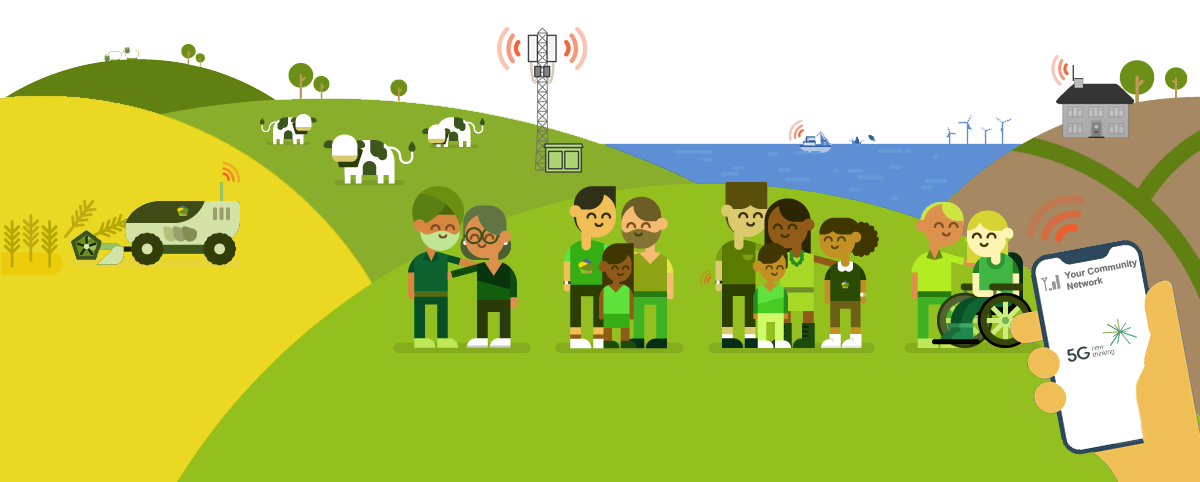Welcome To The 5G New Thinking Rural Connectivity Toolkit
Views
Actions
Namespaces
Variants
Tools

As the world continues to become more and more digitally connected, access to good connectivity is becoming increasingly important in the everyday activities of consumers, businesses, communities, and public service providers. In the UK, Government ambitions for improving coverage of broadband and mobile services have led to various regulations and policies aimed at making it easier to achieve connectivity, especially in remote rural areas. Coupling this with new developments in technology, we are now at the point where communities really can build their own wide-area, high-bandwidth and cost-effective next-generation networks. Such networks could provide traditional broadband and mobile services for local consumers and business, but they could also be 'private' networks for the local sports ground or football stadium, or a temporary 'pop-up' network for an event or festival, for example.
Enabling digital connectivity in rural areas is challenging though. Suitable locations for mast sites are often difficult to access and it can be difficult to get equipment to them; cable runs (for optical fibre, electrical power, etc.) can be long and expensive to install; customers are sparsely populated and the business case is challenging. But despite such challenges, there is much that communities themselves can do to enable digital connectivity in their areas, and the 5G New Thinking Rural Toolkit aims to provide practical support and guidance on what needs to be done and the approaches for doing it.
Each community is different, of course, with different connectivity requirements and different operating environments, along with different inherent skills and capabilities. You will almost certainly need to engage the services of professional consultants and service providers, but there is much that you can do yourselves!
The tasks and activities required for building digital connectivity solutions are varied and wide-ranging, but they can essentially be grouped into three key high-level categories, which can explore by clicking on the following links:
- Create Your Business Plan
This involves identifying your community's needs and the applications and use cases that the network will need to support, as well as working out the business models and the associated cost/revenue analyses and setting up the community enterprise organization that will secure the funding and finance to build and operate the network and 'run the business' going forward. - Plan and Build Your Network
Your network may include optical fibre runs, radio access networks, point-to-point microwave links, masts and electrical power facilities, all of which needs to be planned and designed. You'll need to consider coverage and capacity requirements, end-user devices, access to radio spectrum, access to mast sites and associated planning consent, network security, etc, etc. - Operate Your Network and 'Run Your Business'
Once you've got the business plan defined and the network built, you're ready to start preparing for the operation of the network and running the business.
As you might expect, there is considerable interdependency between the tasks and activities contained within these high-level categories, and the process of setting up and running your network and service provision business will involve a considerable amount of iteration and refinement as things progress.
A note on finding your way around the Toolkit...
You can find your way around the Toolkit by clicking on the sidebar menu symbol in the top left corner of each page. The sidebar will then appear with a list of all of the pages contained in the Toolkit, and you can click on any of these to take you to corresponding page.
- UK 5G Projects, Testbeds and Trials - What's happened so far
ZZZ Something had changed in just the last few years, - you really can build your own wide area, high bandwidth and cost-effective mobile, wireless and broadband networks. Why on earth would you want to do that, and of course how would you do that, what might it cost, and who do you need to help -it's do-able, but not that easy (yet!)? In this section to build your confidence we summarise and link to some of the exciting UK projects using new 5G (and indeed 4G and Wifi) technology to self-provision connectivity (where perhaps there was none!). - Identifying Your Connectivity Needs
Each community is different, and so too are its connectivity needs. You'll need to consider various factors when starting to think about developing a community-led solution for your area. - Business Models
The commercial viability of your community network hinges on the business model being suitable and fit for purpose. This topic will help you to explore features and options that will inform your business model. - Organisational Matters
In order to progress with a connectivity project, a community will need to form a community enterprise. This section describes and compares various community-led organisational structures. - Funding and Finance
In order to develop a community-owned network, you will need to secure funding and finance for your project. This section outlines potential sources of funding and finance for your community venture. - Operations
Any network will require ongoing maintenance and operation. This section considers approaches and options for operating and managing your network. - Technology & Engineering
Your network will require various technological components and engineering activities. This section provides an overview of network architecture and design considerations, ranging from radio and fibre connectivity through to masts and electrical power. - Introduction to Spectrum
One of the most important steps in designing your network is selecting its radio spectrum - carrier frequency and bandwidth - as it influences network performance and equipment availability. This page gives a primer on key principles of the spectrum. - Security
Security takes many forms in private networks, whether device security, user security and so on ZZZ CISCO TO COMPLETE. - Sites & Planning
To build your network, you will require access to land for erecting masts and running fibre. This section considers land access permissions and matters relating to planning consent. - Government Regulations
The Communications Act 2003 governs the activity of Communications Providers in the UK. In order to become an operator, you need to register as a Communications Provider or work with companies that have been granted powers already by Ofcom under the Electronic Communications Code. This section gives an overview of telecommunications regulations related to the provision of telecommunications services in the UK. - Interactive: The 5G NewThinking Rural Connectivity Toolkit also contains interactive tools which allow you to explore different aspects of your rural community's connectivity solution and assess its feasibility as the design evolves. Click here to access the interactive tools.
- Case Studies: ZZZ
- 5G and Public Health: ZZZ

